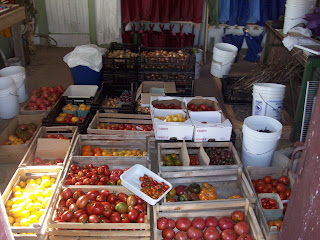The Parker family is just back from the opening of the American Folk Festival. I hope everyone gets a chance to go see some cultural events and check out the great music and dancing. We like to see some of the groups from Louisiana with our Cajun princess!
I didn't get much sleep last night. Not sure why. I was a bit worried about the shares this week I guess. I wasn't sure we were going to have much because of the heat. I never have had so few greens as there are right now in the garden. Actually we have lettuce and endive along with the Chard but it has been so hot and dry that they have all turned bitter. Usually I'd be able to pull off those plantings right up through fall when the next round comes in. Not this year though. However, after last year's solid summer of rain and cold when greens and lettuce where the only things that would grow, I'm not complaining. Plus, my fears were lessened when I went out in the morning to the milk house and took in what was on offer...the results of a hot, dry summer keeping the late blight (now as close as Dixmont) at bay. It will come to the farm eventually when the weather turns but hopefully by then we'll be nearly done harvesting tomatoes anyway.

Look at all those beautiful tomatoes. As I said, I usually have more variety than this at this point but it's been so hot that we're down on variety right now. Luckily, we're up in volume. I could barely lift the coolers today to take to Bangor. I haven't tallied up the harvest record sheets for today yet but I'd say we harvested several hundred pounds of tomatoes and gave out quite a few pounds to each of you. I'll be running some numbers this week if I get a chance and you'll all be getting an email from me regarding totals for the summer and other housekeeping business. We're down to about 7 weeks left and we'll soon be into a different type of weekly offering again with root crops and fall hearty veggies. We'll also be bringing back some of the cool weather crops as we're planting right now for fall and winter. Until then, have fun with the tomatoes! Below is a beautiful shot of the pole beans that were harvested and bagged today. What wonderful color. I'm always interested to know what are people's favorites, not just amount varieties but which ones. In other words, I like to hear from people that they like tomatoes and could do with less lettuce (or vice verse) and also, which types of tomatoes, lettuce, beans, etc. you like best of the ones received. This information and communication is invaluable to me as the person who grows your food. I need to know what you all like to make decisions for next year about what to purchase for seed and grow out.
 A tid-bit about tomatoes that you'll need to know when summer weather changes drastically and briefly as it did this week. We've had a solid month of no substantial rain. That means everything is very, very dry. In the Parker Produce gardens we use age old techniques to mimic nature and protect against fluctuations in weather. This includes loading the soil with organic matter, planting close together and mulching when possible to avoid bare ground, retain moisture and allow for natural cooling around the bases of plants. Therefore, our plants survive without irrigation for longer than most conventional 'farms'. However, plants have defense mechanisms just like humans when things go too far toward one side of the spectrum as this summer has with hot and dry. Tomatoes are a good example. The fruit forms with less water than what is ideally needed. But this week we got a lot of rain in a hurry, the temperature dropped for a day. Both good, except they happened too rapidly after too long. Then the temperature spiked again and the sun came back. With tomatoes that combination (along with harvest schedules) lead to what you see below. Cracking. This is different than the cracking you have seen on some of the large heirlooms. This is a sudden wound that opens in the tomato and doesn't have time to heal the same way as the larger versions that just grow around the opening and callous over. These tomatoes are still edible but you need to eat them right away. Essentially, they are leaking on the rest of them in your bag. If I notice them while bagging I don't put them in, but the volume of tomatoes that Brittany and I deal with means that inevitably, you'll probably get some like this (see below). I ask that our members open up their bags when they get home and go through everything. Take a look at the tomatoes. In fact, the best thing to do is gently poor them out of the bag into a colander. Rinse them to get rid of any tomato juice from a cracked cherry or two and take time to find any that are cracked. Eat them right there or save them for dinner, or whatever. But get the cracked ones out of the pile. Then you can let the others air dry and then store them like you normally would until ready to eat. Not too much work but necessary to keep the one bad tomato from spoiling the rest. Hope you enjoy. See you at the Festival!
A tid-bit about tomatoes that you'll need to know when summer weather changes drastically and briefly as it did this week. We've had a solid month of no substantial rain. That means everything is very, very dry. In the Parker Produce gardens we use age old techniques to mimic nature and protect against fluctuations in weather. This includes loading the soil with organic matter, planting close together and mulching when possible to avoid bare ground, retain moisture and allow for natural cooling around the bases of plants. Therefore, our plants survive without irrigation for longer than most conventional 'farms'. However, plants have defense mechanisms just like humans when things go too far toward one side of the spectrum as this summer has with hot and dry. Tomatoes are a good example. The fruit forms with less water than what is ideally needed. But this week we got a lot of rain in a hurry, the temperature dropped for a day. Both good, except they happened too rapidly after too long. Then the temperature spiked again and the sun came back. With tomatoes that combination (along with harvest schedules) lead to what you see below. Cracking. This is different than the cracking you have seen on some of the large heirlooms. This is a sudden wound that opens in the tomato and doesn't have time to heal the same way as the larger versions that just grow around the opening and callous over. These tomatoes are still edible but you need to eat them right away. Essentially, they are leaking on the rest of them in your bag. If I notice them while bagging I don't put them in, but the volume of tomatoes that Brittany and I deal with means that inevitably, you'll probably get some like this (see below). I ask that our members open up their bags when they get home and go through everything. Take a look at the tomatoes. In fact, the best thing to do is gently poor them out of the bag into a colander. Rinse them to get rid of any tomato juice from a cracked cherry or two and take time to find any that are cracked. Eat them right there or save them for dinner, or whatever. But get the cracked ones out of the pile. Then you can let the others air dry and then store them like you normally would until ready to eat. Not too much work but necessary to keep the one bad tomato from spoiling the rest. Hope you enjoy. See you at the Festival!


















